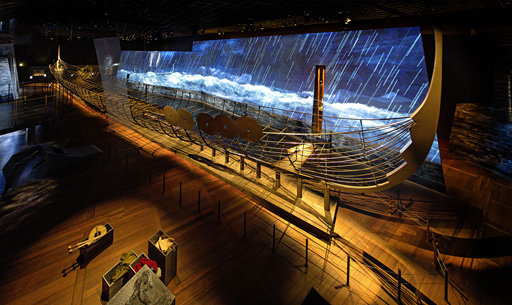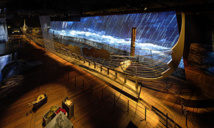Their uncultivated reputation was certainly ingrained at the time, far beyond their Scandinavian homelands.
"They are the filthiest of God's creatures," wrote Arab diplomat Ahmad ibn Fadlan in 921.
"They do not clean themselves after urinating or defecating, nor do they wash after having sex. They do not wash their hands after meals. They are like wandering asses."
But at the British Museum in London, some of the finery on show includes a splendid -- if well-used -- iron sword, alongside jewellery, amulets, religious images and exquisite objects.
The exhibition -- the museum's first on the Vikings in more than 30 years, costing £16.50 ($27.50, 20 euros) to enter -- shows how the Nordic warriors created an international network of trade, plunder and power spreading across four continents.
They generally treated their slaves well to maintain their market value. And when the exhibition finally turns to bones and remains, they belong to the Vikings and not to those they attacked.
"Violent warriors is certainly an important part of the story; it's not the only part," the exhibition's curator Gareth Williams told AFP.
"They were traders, they were craftsmen, they were explorers, they were many different things. An important part of the message we want to give people here is that this is a complex and multi-layered society."
- Ships 'underpin everything' -
Their shipbuilding and seafaring skill was at the heart of their culture and achievements and the centrepiece of the exhibition is the surviving timbers from the longest Viking warship ever found.
Discovered in a Danish fjord in 1997, the 37-metre long ship, since given the name Roskilde 6, dates back to around 1025 -- the high point of the Viking Age.
A metal framework supports the remaining oak timbers.
It is at once an instrument of exploration, conquest and commerce, a mighty weapon of war and a work of art, sculpted, painted in silver and gold that would shine in the sun.
"It must be built either for a king or a great chieftain," said Williams.
"The ships and the seamanship of the Vikings underpin everything in this exhibition. It's ships that enable them to go out and interact with peoples around that wider Viking world."
Viking influence extended from Newfoundland in North America to Afghanistan in central Asia, and around the Mediterranean -- and not all through plunder.
The Vikings' warrior reputation might be a one-sided view, Williams suggested, saying they were probably no more bloodthirsty than other peoples in a violent age.
He said the Vikings attacked Christian churches, and monks produced most of the written records of the time.
"It's not that they're attacking more violently; it's what they're choosing to attack and who's writing it," the curator said.
"There's a saying that history is always written by the victors. Actually, the history of the Vikings is written by the losers -- and they're not good losers."
------------------------------------------------------------------
"They are the filthiest of God's creatures," wrote Arab diplomat Ahmad ibn Fadlan in 921.
"They do not clean themselves after urinating or defecating, nor do they wash after having sex. They do not wash their hands after meals. They are like wandering asses."
But at the British Museum in London, some of the finery on show includes a splendid -- if well-used -- iron sword, alongside jewellery, amulets, religious images and exquisite objects.
The exhibition -- the museum's first on the Vikings in more than 30 years, costing £16.50 ($27.50, 20 euros) to enter -- shows how the Nordic warriors created an international network of trade, plunder and power spreading across four continents.
They generally treated their slaves well to maintain their market value. And when the exhibition finally turns to bones and remains, they belong to the Vikings and not to those they attacked.
"Violent warriors is certainly an important part of the story; it's not the only part," the exhibition's curator Gareth Williams told AFP.
"They were traders, they were craftsmen, they were explorers, they were many different things. An important part of the message we want to give people here is that this is a complex and multi-layered society."
- Ships 'underpin everything' -
Their shipbuilding and seafaring skill was at the heart of their culture and achievements and the centrepiece of the exhibition is the surviving timbers from the longest Viking warship ever found.
Discovered in a Danish fjord in 1997, the 37-metre long ship, since given the name Roskilde 6, dates back to around 1025 -- the high point of the Viking Age.
A metal framework supports the remaining oak timbers.
It is at once an instrument of exploration, conquest and commerce, a mighty weapon of war and a work of art, sculpted, painted in silver and gold that would shine in the sun.
"It must be built either for a king or a great chieftain," said Williams.
"The ships and the seamanship of the Vikings underpin everything in this exhibition. It's ships that enable them to go out and interact with peoples around that wider Viking world."
Viking influence extended from Newfoundland in North America to Afghanistan in central Asia, and around the Mediterranean -- and not all through plunder.
The Vikings' warrior reputation might be a one-sided view, Williams suggested, saying they were probably no more bloodthirsty than other peoples in a violent age.
He said the Vikings attacked Christian churches, and monks produced most of the written records of the time.
"It's not that they're attacking more violently; it's what they're choosing to attack and who's writing it," the curator said.
"There's a saying that history is always written by the victors. Actually, the history of the Vikings is written by the losers -- and they're not good losers."
------------------------------------------------------------------









 Home
Home Politics
Politics











